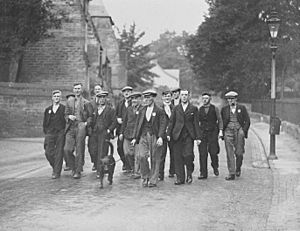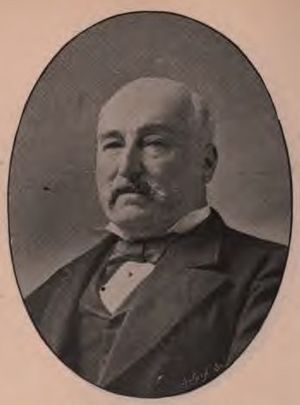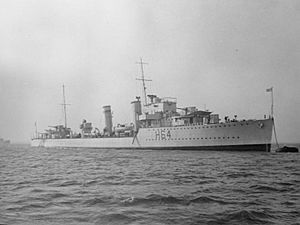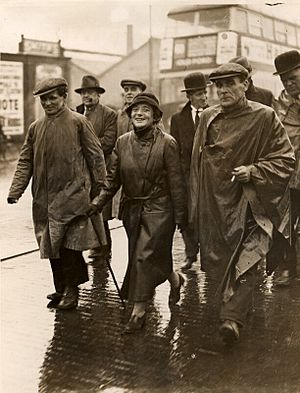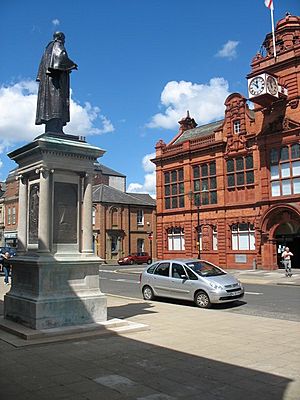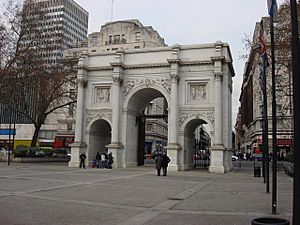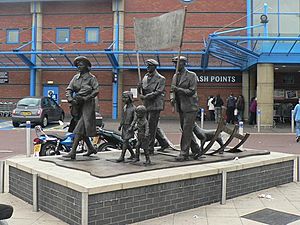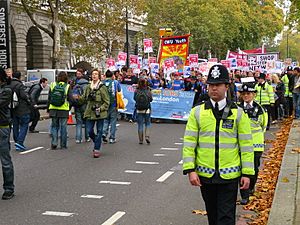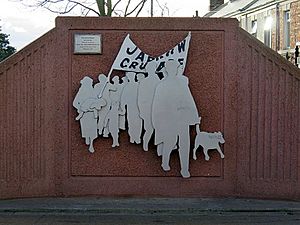Jarrow March facts for kids
The Jarrow March, also known as the Jarrow Crusade, was a famous protest walk that happened from 5 to 31 October 1936. It was organized to show how much people in the English town of Jarrow were suffering from unemployment and poverty. About 200 men, who called themselves "Crusaders," walked all the way from Jarrow to London. They carried a special request, called a petition, for the British government. They wanted the government to help bring jobs back to their town.
Jarrow's main employer, Palmer's shipyard, had closed in 1934. This closure left many people without work. The petition was given to the House of Commons, which is where laws are made in Britain. However, the politicians did not discuss it. The march didn't seem to change things right away, and the people from Jarrow felt like they had failed when they went home.
Jarrow had been a town for a very long time, since the 700s. In the early 1800s, coal mining became important. Then, in 1851, the shipyard opened. For the next 80 years, more than 1,000 ships were built in Jarrow. But in the 1920s, the shipyard faced problems. Poor management and changes in world trade after the First World War caused it to decline. This led to its closure. There were plans to build a new, modern steel factory, but a powerful group of steel companies, the British Iron and Steel Federation, stopped it. They had their own plans for the industry. Because the steel factory plan failed and there were no other jobs, the people of Jarrow decided to march.
People who were unemployed had marched to London before. These were called "hunger marches." They were mostly organized by a group called the National Unemployed Workers' Movement (NUWM). This group had links to the Communist Party. Because of this, the main Labour Party and Trades Union Congress (TUC) leaders usually stayed away from these marches. They also kept their distance from the Jarrow March. However, the Jarrow March was organized by the local town council and supported by everyone in the town. It had no connection to the NUWM. As the Jarrow marchers walked, they received food and places to stay from local groups of all the main political parties. When they arrived in London, many people welcomed them.
Even though the marchers felt they had failed at first, the Jarrow March later became known as a very important event of the 1930s. It helped change how people thought about social problems. This change helped lead to new laws and programs after the Second World War that aimed to make working conditions better. Today, Jarrow has many memorials to the march. People have even re-enacted the march on its 50th and 75th anniversaries. These re-enactments also protested unemployment, showing the "spirit of Jarrow." Unlike in 1936, the Labour Party leaders after the war started to see the march as a symbol of how uncaring the government could be and how strong working people were.
Contents
Why the March Happened: A Look at Britain
Unemployment Across the Country
After the First World War ended, Britain's economy had a short period of growth. Businesses were busy, prices went up, and most people had jobs. But by 1920, this growth ended, and Britain entered a time of high unemployment. The government's economic choices, like returning to the gold standard in 1925, meant that about 10% of workers had no jobs for the rest of the 1920s. This was much higher than before the war.
During the world recession from 1929 to 1932, unemployment got even worse. It reached 22%, meaning more than 3 million people were out of work.
| Year | Total % |
SE England % |
NE England % |
Ship- building % |
|---|---|---|---|---|
| 1923 | 11.7 | 9.2 | 12.2 | 43.6 |
| 1924 | 10.3 | 7.5 | 10.9 | 30.3 |
| 1925 | 11.3 | 5.9 | 15.0 | 33.5 |
| 1926 | 12.5 | 5.4 | 17.2 | 39.5 |
| 1927 | 9.7 | 5.0 | 13.7 | 29.7 |
| 1928 | 10.8 | 5.4 | 15.1 | 24.5 |
| 1929 | 10.4 | 5.6 | 13.7 | 25.3 |
| 1930 | 16.1 | 8.0 | 20.2 | 27.6 |
| 1931 | 21.3 | 12.0 | 27.4 | 51.9 |
| 1932 | 22.1 | 14.3 | 28.5 | 62.0 |
| 1933 | 19.9 | 11.5 | 26.0 | 61.7 |
| 1934 | 16.7 | 8.7 | 22.1 | 51.2 |
| 1935 | 15.5 | 8.1 | 20.7 | 44.4 |
| 1936 | 13.1 | 7.3 | 16.8 | 33.3 |
Unemployment was especially bad in Britain's old main industries. These included coal mining, shipbuilding, iron and steel, and textiles. All of these were slowly declining. Because these industries were mostly in the north of England, Scotland, and Wales, unemployment rates in these areas were much higher. Sometimes they were more than double the rates in the south. This decline led to many people being jobless for years.
What Were Hunger Marches?
In 1921, as unemployment grew, the new British Communist Party started the National Unemployed Workers' Movement (NUWM). From 1922 until the late 1930s, the NUWM organized regular marches. Unemployed workers would walk to London to protest to Parliament. These marches became known as "hunger marches."
In 1922, marchers wanted to meet the prime minister, but he refused. He said their leaders were not chosen by the people. Newspapers called the leaders "Communists" who caused trouble. The Labour Party and the TUC stayed away from these marches. They didn't want to be linked to the Communist organizers. This happened with later NUWM marches too. Prime ministers refused to meet the marchers.
In 1931, the government introduced a "means test" for unemployment benefits. This meant people had to prove they were poor enough to get help. This made many people angry. The 1932 hunger march saw protests and violence in London. Leaders were arrested. While women were not allowed on the Jarrow march, women often joined other hunger marches. These women, often wives of unemployed men, faced difficulties.
By 1934 and 1936, Britain was recovering from the worst of the depression. Unemployment was lower, and many parts of the country were doing well. But this prosperity was not everywhere. The north-east, South Wales, and Scotland were still struggling. People were also becoming more aware of the problems faced by the unemployed. Marching to protest had become a common way to show unhappiness.
Jarrow's Story: Why This Town Marched
Town History
Jarrow is a town on the River Tyne in northern England. It became famous in the 700s as the home of Bede, a well-known monk and scholar. For a thousand years, Jarrow remained a quiet farming community. But in the 1600s, coal was discovered. Large-scale mining began in the early 1800s. This caused Jarrow's population to more than double between 1801 and 1821, mostly due to miners moving in.
Life in Jarrow during the coal mining years was hard. The quickly built homes were unhealthy, with no clean water or proper drains. A serious disease called cholera spread in 1831–32, killing many people. Relations between mine owners and workers were bad. Workers were tied to one employer for a year, even if there was no work. Mining was dangerous, with explosions in 1826, 1828, and 1845 that killed many. Owners fought against workers trying to form a union. Still, miners went on long strikes in 1832 and 1844. These strikes ended only when hunger forced them back to work. As the easier coal was mined, Jarrow's pits became less profitable. In 1851, the owners closed them completely.
The Rise and Fall of Shipbuilding
Jarrow started to become a shipbuilding town when Palmer's shipyard opened in 1851. The first ship, an iron-built steam-powered coal carrier, was launched in 1852. Many more carriers followed. In 1856, the shipyard began building warships for navies around the world. With its iron and steel works, it became the biggest shipbuilding center in Britain. Thousands of men worked there. Jarrow's population grew from about 3,800 in 1850 to 35,000 by 1891. Palmer's was vital to Jarrow's economy.
The shipyard brought many jobs, but the industrial work made Jarrow a tough place to live. Ellen Wilkinson, who later became Jarrow's Member of Parliament, quoted a newspaper from 1858: "Everything is black. The houses are black, the ships are black, the sky is black." She also said that the shipyard's founder, Sir Charles Palmer, did not care about the living conditions of his workers.
In the 1890s, Britain built almost all the world's ships. This share dropped to about 60% in the early 1900s as other countries started building more. Palmer's stayed busy, especially during the First World War. They built many warships for Britain. After the war, there was a short period of growth, and Palmer's did well. However, the company's leaders did not expect that other countries would start building their own ships. Palmer's made wrong predictions about future demand and invested too much. The expected demand didn't happen. By the mid-1920s, Palmer's was losing a lot of money and was almost bankrupt. A small boom in 1929 gave them a brief hope, but it didn't last.
The Closure of Palmer's Shipyard
On 24 July 1930, Palmer's launched its thousandth ship. But by then, the short shipbuilding boom had ended because of the Great Depression. There were no new orders for the company. Rumors spread about changes in the industry, causing worry among workers. In 1930, a company called National Shipbuilders Security Ltd (NSS) was formed. This company was created by the government to help shipbuilders. NSS bought failing shipyards and closed them down. This was to make sure that shipbuilding was concentrated in fewer, more profitable yards. Once a yard was closed by NSS, it was not allowed to build ships for at least 40 years.
In 1931, NSS was busy closing shipyards elsewhere. Palmer's kept working until mid-1932 thanks to an order for two destroyers from the Admiralty. The second of these ships was HMS Duchess, launched on 19 July 1932. This was the last ship built at the yard. By this time, Palmer's was out of money. They hoped for more naval contracts, but none came. In June 1933, the company's lenders took control. By December 1933, there were rumors that NSS was interested in buying the yard. In the House of Commons, Walter Runciman, a government minister, said there was no hope for Palmer's to reopen. He suggested it would be better to close it as a shipyard and sell the land. Despite efforts by the company and workers, NSS bought the yard in early summer 1934. They closed it and began taking it apart.
After Palmer's closed, a small hope came from a businessman named Sir John Jarvis. He promised to bring new industries to Jarrow, like ship breaking, bottle making, and furniture making. While his idea was kind, it didn't solve the town's huge problems. One writer said, "This excellent man failed, as anyone must fail who tries to play the good squire to a town of nearly forty thousand people."
Ellen Wilkinson: Jarrow's Champion
In the 1931 election, the Labour Party lost many seats, and Jarrow elected a Conservative politician. By 1932, Jarrow was in despair. The local Labour Party chose Ellen Wilkinson as their candidate for the next election. Wilkinson had been involved with the Communist Party earlier but left it. She had served as a Labour Member of Parliament (MP) before.
Wilkinson felt a strong connection to the people of Jarrow and understood their pain from losing the shipyard. In 1934, she led a group of unemployed people from Jarrow to meet the prime minister. She became Jarrow's MP in November 1935. In her first speech in Parliament, she spoke for her new constituents. She said, "These are skilled fitters, men who have built destroyers and battleships... The years go on and nothing is done... this is a desperately urgent matter."
The Failed Steelworks Plan
While Jarvis was trying to help, a bigger plan to bring industry back to Jarrow was being considered. An American businessman, T. Vosper Salt, saw that Palmer's yard was being sold. He believed that the world would soon need more steel. He thought the Jarrow site, with its docks and rail lines, would be perfect for a new, modern steelworks. In January 1934, Salt started talking with the British Iron and Steel Federation (BISF). This group controlled the British steel industry.
The British steel industry was protected from foreign competition by high taxes on imported steel. The BISF also controlled prices and could stop new competition at home. When Salt's plan was presented to the BISF in March 1935, their chairman seemed positive at first. But other BISF members, especially those from the north-east, were not happy. They put pressure on banks in London to not lend money for the new Jarrow steelworks. This made people in Jarrow very worried, as they desperately wanted the new factory. The prime minister, Baldwin, tried to reassure them, saying there was no truth to rumors that banks were trying to stop the project.
After the election, nothing happened to support Baldwin's hopeful words. In Parliament in March 1936, Wilkinson spoke about the "mystery" around the Jarrow plan. The BISF argued that steel production should increase by expanding existing factories, not building new ones. The BISF chairman, who had been positive before, now opposed funding for Jarrow. He worried it would set a bad example for other struggling areas. The BISF managed to weaken the plan so much that it became impossible to do. Salt and his group gave up. Wilkinson said the plan was "strangled at birth."
Wilkinson tried to get the government to reconsider the issue, but they refused. A government negotiator wrote in a newspaper that a system allowing groups with financial interests to decide on important national projects was not good for the steel industry.
Later that summer, Wilkinson and other Jarrow workers met with the minister, Runciman. Wilkinson described him as "a figure of ice... completely indifferent to the woes of others." His statement that "Jarrow must work out its own salvation" was seen as very cruel. Wilkinson said this phrase "kindled the town" and inspired them to act.
The March: A Journey for Jobs
Getting Ready for the Walk
After the steelworks plan failed, David Riley, a leader in Jarrow, told a meeting of unemployed people in July 1936: "If I had my way I would organize the unemployed of the whole country... and march them on London." He believed this would force the government to listen. The idea of a march was enthusiastically supported by the mayor, Billy Thompson, by Ellen Wilkinson, and by all groups in the town. They decided the march would be just for Jarrow, without any political party links. It would involve 200 fit men. They would arrive in London when Parliament started its new session on 3 November 1936. Then, they would present their petition.
Riley became the main organizer. All local political parties—Labour, Conservative, and Liberal—supported the march. Churches and businesses also helped. Medical students volunteered to walk with the marchers as medics. A fund was started to pay for the march, aiming for £800. They ended up raising almost double that amount. Public meetings were planned for each overnight stop to tell people about Jarrow's problems. One marcher said they were "missionaries of the distressed areas."
On Monday, 5 October, the marchers, chosen from over 1,200 volunteers, attended a church service in Jarrow. The Bishop of Jarrow gave his blessing. This support from a church leader got a lot of attention in the news. However, the Bishop of Durham strongly disagreed. He called the march "revolutionary mob pressure" and criticized his colleague.
As Jarrow's marchers prepared to leave, other groups of unemployed people were also marching to London. A group of blind veterans was also marching, asking for better support.
On the Road to London
| Stage | Date | From | To | Distance |
|---|---|---|---|---|
| 1 | Mon 5 Oct | Jarrow | Chester-le-Street | 12 mi (19 km) |
| 2 | Tue 6 Oct | Chester-le-Street | Ferryhill | 12 mi (19 km) |
| 3 | Wed 7 Oct | Ferryhill | Darlington | 12 mi (19 km) |
| 4 | Thu 8 Oct | Darlington | Northallerton | 16 mi (26 km) |
| 5 | Fri 9 Oct | Northallerton | Ripon | 17 mi (27 km) |
| Sat 10 Oct | Rest days | — | ||
| Sun 11 Oct | ||||
| 6 | Mon 12 Oct | Ripon | Harrogate | 11 mi (18 km) |
| 7 | Tue 13 Oct | Harrogate | Leeds | 15 mi (24 km) |
| 8 | Wed 14 Oct | Leeds | Wakefield | 9 mi (14 km) |
| 9 | Thu 15 Oct | Wakefield | Barnsley | 10 mi (16 km) |
| 10 | Fri 16 Oct | Barnsley | Sheffield | 13 mi (21 km) |
| 11 | Sat 17 Oct | Sheffield | Chesterfield | 12 mi (19 km) |
| Sun 18 Oct | Rest day | — | ||
| 12 | Mon 19 Oct | Chesterfield | Mansfield | 12 mi (19 km) |
| 13 | Tue 20 Oct | Mansfield | Nottingham | 14 mi (23 km) |
| 14 | Wed 21 Oct | Nottingham | Loughborough | 15 mi (24 km) |
| 15 | Thu 22 Oct | Loughborough | Leicester | 11 mi (18 km) |
| 16 | Fri 23 Oct | Leicester | Market Harborough | 14 mi (23 km) |
| 17 | Sat 24 Oct | Market Harborough | Northampton | 17 mi (27 km) |
| Sun 25 Oct | Rest day | — | ||
| 18 | Mon 26 Oct | Northampton | Bedford | 21 mi (34 km) |
| Tue 27 Oct | Rest day | — | ||
| 19 | Wed 28 Oct | Bedford | Luton | 19 mi (31 km) |
| 20 | Thu 29 Oct | Luton | St Albans | 10 mi (16 km) |
| 21 | Fri 30 Oct | St Albans | Edgware | 11 mi (18 km) |
| 22 | Sat 31 Oct | Edgware | Marble Arch, London | 8 mi (13 km) |
| Total | 291 mi (468 km) | |||
First Week: Jarrow to Ripon
After the church service, the marchers left Jarrow Town Hall. Most of the town cheered them on. They carried banners that said "Jarrow Crusade." By the next weekend, they had walked 69 mi (111 km) to the city of Ripon. There, the Bishop of Ripon and local church leaders welcomed them. The welcomes at other stops were mixed. Some were not very warm, while others, like in Ferryhill and Darlington, were friendly.
Ellen Wilkinson left the march briefly to attend a Labour Party meeting. The Labour Party conference was not very supportive of the march. One person criticized Wilkinson for "sending hungry and ill-clad men on a march." This made the marchers angry. They also learned that their unemployment benefits would be cut because they were not available for work while marching.
Second Week: Ripon to Chesterfield
After a weekend rest, the marchers continued to Harrogate. This was a wealthy, Conservative town. But the marchers were warmly welcomed by the town leaders and fed by the Rotary Club. They slept in military buildings, which was a change from the schools and church halls they usually stayed in. It became clear that local Conservatives often helped as much as Labour supporters. The marchers emphasized that their situation was special. They argued that the government could fix it by reopening the shipyard or allowing the steelworks. This message may have helped them get support from different groups. David Riley refused a donation from a communist group, saying they wanted to keep the march "non-political."
Ellen Wilkinson rejoined the march in Harrogate. The march was getting a lot of attention. The government in London was worried that King Edward might meet the marchers. The government released a statement saying that people should use official ways to complain. They also said marches caused "unnecessary hardship." Wilkinson called this "crocodile tears." By 17 October, the marchers reached Chesterfield, having walked 70 mi (110 km) that week. They were about halfway to London. On that day, the Bishop of Jarrow wrote to The Times newspaper. He said his blessing was just a Christian duty and that he didn't support such marches. Wilkinson understood his change of heart, knowing he faced "difficulties."
Third Week: Chesterfield to Northampton
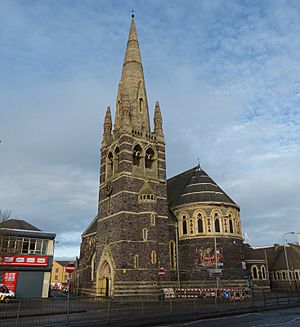
The third week was the longest, covering 83 mi (134 km). In Mansfield, the Labour-controlled council welcomed the marchers warmly, even though their national party was not supportive. The Conservative mayor and council in Nottingham also gave a warm welcome. Manufacturers in Nottingham donated clothes. In Leicester, shoemakers at the Co-operative Society worked all night for free to repair the marchers' boots.
From Leicester, the march went to Market Harborough. This was one of the least welcoming stops. No local council members greeted the marchers. They had to sleep on the stone floor of an unfinished building. On Saturday, 24 October, the marchers reached Northampton. Ellen Wilkinson left to prepare for their arrival in London. She would only join them again on the final day.
Fourth Week: Northampton to London
On Monday, 26 October, the marchers walked 21 mi (34 km) from Northampton to Bedford. This was their longest daily walk. Of the original 200 men, 185 were still walking, plus 10 replacements. To arrive at Marble Arch on time, they took an extra rest day. Then they walked 19 mi (31 km) to Luton in heavy rain.
On 29 October, as the marchers walked from Luton to St Albans, Ellen Wilkinson spoke about Jarrow in the House of Commons. The prime minister said that unemployment in Jarrow had decreased. Wilkinson replied that this was because Jarrow's numbers were combined with those of a nearby town, South Shields. She asked the prime minister to meet the marchers, but he refused.
On the second-to-last day, from St Albans to Edgware, the marchers began to think about going home. They worried about having "nothing, nothing at all to do." On the final day, for the short 8 mi (13 km) walk, large crowds watched them. They marched through London's suburbs, playing their mouth-organ band, despite the rain. When they arrived at Marble Arch, their leaders spoke to the press. The marchers then went to their lodging in London's East End.
In London
On Sunday, 1 November, the marchers went to Hyde Park for a public meeting. The Communist Party was also holding a rally there. They kindly let the Jarrow marchers use their audience. One journalist estimated 50,000 people were there.
After a day of rest, the marchers' main event on Tuesday was a public meeting. A speaker told them, "You have so aroused the conscience of the country that things are bound to happen." Sir John Jarvis then surprised everyone by announcing plans for a steel tubes factory at the old Palmer's site. This made the marchers uneasy, as it suggested Jarrow's problems could be solved without government help. Wilkinson said these plans were for the future and didn't solve the town's immediate need for government action.
On Wednesday, 4 November, Ellen Wilkinson presented the Jarrow petition to the House of Commons. It had over 11,000 signatures. It asked the government to provide work for the town quickly. In the short discussion, the minister Runciman said Jarrow's unemployment had improved. Another Labour MP replied that the government's calm attitude was "an affront to the national conscience."
One writer summarized the marchers' disappointment: "And that was that. The result of three months' excited preparation and one month's march has led to a few minutes of flaccid argument." A short "stay-in" strike was suggested. Wilkinson then arranged a meeting with a group of MPs from different parties. The MPs listened with sympathy. They were warned that dismantling a shipbuilding facility for private profit might be regretted later. Wilkinson said these statements made the MPs "distinctly uncomfortable." The next day, the marchers returned to Jarrow by train. The town gave them an excited welcome.
What Happened Next: The March's Impact
Before the Second World War started, Jarvis's efforts brought some small relief to Jarrow. By 1939, about 100 men worked in a small furniture factory. Up to 500 more worked in metal industries on the old Palmer's site. Jarvis even bought old ships to be broken up at the yard. However, many marchers felt their effort had failed after their triumphant return home. Con Whalen, the last survivor of those who walked the whole way, said the march was "a waste of time," but he enjoyed every step. Another marcher said, "The march produced no immediate startling upsurge in employment in the town. It took the war to do that." Most historians agree with these views. The Daily Mirror columnist Kevin Maguire called the march "a heroic failure."
However, the Jarrow March has become a powerful symbol over time. The Labour Party, which avoided the march in 1936, later used it as a sign of their commitment. In 1950, the party put the Jarrow banners on their election posters. The march was less talked about when jobs were plentiful. But when unemployment became a problem again in the 1980s, the march was remembered. Labour leaders like Michael Foot, Neil Kinnock, and Tony Blair have all connected themselves to the march. In October 1986, on the 50th anniversary, people from Jarrow and other towns re-walked the route. At that time, Jarrow again had the highest unemployment in the country. The 75th anniversary in 2011 was marked by a "March for Jobs."
Shortly after returning home in November 1936, David Riley and three other Jarrow council members who led the march left the Labour Party. They formed a new group to fight directly for jobs. All four later rejoined the Labour Party. Two of them, Paddy Scullion and Joseph Symonds, became mayor of Jarrow. Symonds also became a Labour MP. In 1939, Ellen Wilkinson published her book about Jarrow, The Town that Was Murdered. Wilkinson continued her political career. She served as a minister in the government during the war. In 1945, she became the Minister of Education, a very important job, until she died in 1947.
In 1974, the singer Alan Price released the "Jarrow Song." This song helped new generations learn about the events of 1936. There have also been plays and an opera based on the Jarrow March. In 2017, the Tyne Bridge was closed for an event that re-enacted parts of the march. Jarrow has several memorials to the march. These include a steel sculpture at the railway station, a tile mural by schoolchildren, and a bronze sculpture called "The Spirit of the Crusade" in the town center. Buildings and streets are named after Wilkinson and Riley.
|


